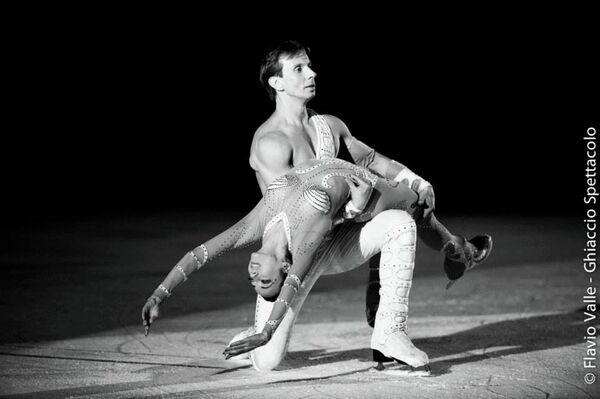MOSCOW, March 7 (by Kevin O’Flynn, RIA Novosti) – One item was very different from the others at a recent exhibit on Soviet participation in the Winter Olympic Games. Amid Central Committee documents and photos of gold medal-winning athletes was a letter written in a child's scrawl.
The letter, dating back to 1987, begins "To dear Mr Gorbachov." In red ink with drawings in the margins, it told of a small girl's love for Russian ice skaters. Fiona Zaldua had seen them performing on television, and wrote to the leader of the Soviet Union to tell him that "they were the best I have ever seen. I love ice skating and I skate at Slough ice rink in England."
The letter ends with a request from Zaldua: "I am nine years old and would love to skate in Russia. Please could you ask some of your champion skaters to teach me." In the bottom left hand corner, she has written her name and address, complete with the postal code for a speedy reply.

It is accompanied by Zaldua's brightly colored drawing of an ice skating pair, which she also sent to Gorbachev.
There is hardly any information about the letter at the exhibit, just a few words stating that the letter was sent by a British girl in the 1980s. The drawing has been stamped with the number 16828, the reference number from the federal archive where it had remained for almost three decades.
Gorbachev never answered Zaldua's letter. Nevertheless, she found her own Russian trainers, and is now a world class skater.
Zaldua had no idea her letter was on show, and only found out when contacted by The Moscow News. To this day, she remembers writing the letter.
"I was always admiring the Russian skaters," she said in a phone interview from England, after being sent a copy of her own letter. "When I saw the skaters that time, I remember thinking to myself, ‘How can they be so good? How can they win everything?'"
Zaldua's mother brought her to the rink for the first time when she was seven. By the time she wrote the letter, she said, skating had become a means of escape from her parents' divorce and bullying at school.

"Can I just go to Russia and skate there? I don't want to stay here," she told her mother after seeing Russian skaters on TV. Her mother explained that you had to be invited to go to the Soviet Union. "I said, ‘How do I do that?'"
"You'll have to write to the government in order to get invited," her mother replied.
So she wrote to Gorbachev.
"[My mother] used to get annoyed at me because I used to write a lot of letters to different people," Zaldua said. "I didn't know this, but she said that she didn't send half the letters I used to write. On this occasion, I was really persistent, saying, ‘Send it, send it, send it.' ... And then you got in touch 27 years later."
All letters sent to Gorbachev at the time were sorted, with the most interesting ones chosen to go into the archive, according to Irina Kazarina of the Russian State Archive of Contemporary History.
Zaldua's letter caught the curators' eye when they were gathering material for the exhibit, she said. It was a good representation of perestroika, she said, a time when the Soviet Union started to open up to the West and attitudes to the Soviet Union began changing.
At the archive, no one knew that Zaldua had gone on to become an ice skater until after the exhibit began. Researchers were astounded to see her appearing on "Ice Age," the prime time ice dancing show on Russian TV.
"It looks like all her dreams came true," Kazarina said.
The most famous child to write to a Soviet leader was Samantha Smith, a 10-year-old American girl who in 1982 wrote to Yury Andropov about her worries about a nuclear war. She became famous around the world and visited the Soviet Union in 1983. After her death in a plane crash in 1985, she was honored on a Soviet stamp.
Zaldua continued to skate as a child, getting up at 4:30 in the morning to train. When she was 17, she turned to Russians once more, going to a skating school that had been set up by trainers in England.
"It was the last chance for my skating career," she said.
The break-up of the Soviet Union brought an exodus of ice skating trainers and ice skaters from Russia as money in the state-funded system dried up. This school just outside London brought the techniques that made Russian skaters the best in the world.
"When I got there, I couldn't walk for a week because they worked me so hard," she said. "It hurt so much, but it was what I wanted to do more than anything else, so I stuck to it."
It was at the school that she met Dmitri Sukhanov, a former world junior champion pairs skater, and the two became partners on and off the ice. Unbeknownst to Zaldua, her letter was on display at the federal archives when she was in Moscow in December while performing on "Ice Age."
Her name is now up all around the city on posters advertising Olympic champion Evgeni Plushenko's post-Olympic skating show. Zaldua, along with her now-husband Sukhanov, are listed as featured guests.
Zaldua said she would love to see the letter, but the exhibit is now closed. She was also curious about how it got there. What address did her mother put?
"Did you ever see the envelope to the letter? I was curious to see what was on it," she said.
Kazarina said that there was no sign of the envelope, but that Zaldua could come to the archive to see the letter in person.

